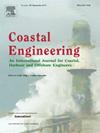Predicting wave runup on composite beaches
IF 4.5
2区 工程技术
Q1 ENGINEERING, CIVIL
引用次数: 0
Abstract
Empirical formulae for predicting wave runup (the maximum elevation reached by the water on a wave-by-wave basis) have not been widely tested on composite beaches, which have a characteristic cross-shore boundary in sediment size and slope. Using video-derived runup observations from two natural composite beaches in Oregon, U.S.A during both berm collision and inundation, the performance of existing empirical runup formulae was examined. The tested formulae were developed for sandy beaches, cobble beaches, and composite beaches. The sandy beach formulae showed good correlation with composite beach observations, however all but one tended to overpredict observations by 1–2 m. The overprediction depended in part on the definition used for beach slope, and is likely also a function of swash zone position and berm sediment characteristics. One sandy beach formula (that of Medellin et al., 2016; https://doi.org/10.5194/nhess-16-167-2016) and a modified version of a cobble beach formula (from Poate et al., 2016; https://doi.org/10.1016/j.coastaleng.2016.08.003) were found to show good performance, with root mean squared errors (RMSE) of 0.55 m and 0.63 m, respectively (26 % and 30 % compared to the mean of 2.09 m), when the average of the beach and berm slopes was used. The only existing composite beach formulae were found to fit our observations during berm collision poorly, though performed more strongly for observations during berm inundation. Since those formulae were developed for the case of berm inundation, and the observations used here encompassed both berm collision and inundation, the results suggest that a more general formula encompassing both impact regimes is needed. By deconstructing the sources of error in the existing composite beach runup formulae, we identified parameterizations for wave setup and swash excursion to fit the present dataset of berm collision and inundation. The newly developed formula performs similarly though slightly worse than the existing composite beach formulae for a limited set of inundation observations, however across all observations (inundation and collision) the new formula obtains RMSE = 0.48 m (23 % of average observed ) when the average of the beach and berm slopes is used, less than half of the existing composite beach formulae and lower than any other tested formula.
预测复合海滩上的浪涌
预测浪涌的经验公式(水在一波一波的基础上达到的最大高度)尚未在复合海滩上广泛测试,复合海滩在沉积物大小和坡度方面具有典型的跨海岸边界。利用美国俄勒冈州两个天然复合海滩在护堤碰撞和淹没期间的视频推导的累积观测,对现有经验累积公式的性能进行了检验。试验公式分别适用于沙滩、鹅卵石沙滩和复合沙滩。沙滩公式与综合沙滩观测值具有良好的相关性,但除一个公式外,其他公式均倾向于高估1 ~ 2 m。过度预测部分取决于对海滩坡度的定义,也可能是冲刷带位置和护堤沉积物特征的函数。一个沙滩公式(Medellin et al., 2016;https://doi.org/10.5194/nhess-16-167-2016)和修改版本的鹅卵石海滩公式(来自Poate等人,2016;https://doi.org/10.1016/j.coastaleng.2016.08.003)显示出良好的性能,当使用海滩和护堤坡度的平均值时,均方根误差(RMSE)分别为0.55 m和0.63 m(与平均R2% 2.09 m相比,RMSE分别为26%和30%)。现有的唯一复合海滩公式被发现与我们在护堤碰撞期间的观测结果拟合较差,尽管在护堤淹没期间的观测结果表现得更强。由于这些公式是针对堤岸淹没的情况开发的,而这里使用的观测结果既包括堤岸碰撞也包括淹没,因此结果表明,需要一个包含两种影响机制的更一般的公式。通过解构现有复合海滩上升公式中的误差来源,我们确定了海浪设置和冲刷偏移的参数化,以适应当前的护堤碰撞和淹没数据集。新开发的公式在有限的淹没观测值中表现类似,但略低于现有的复合海滩公式,但是在所有观测值(淹没和碰撞)中,当使用海滩和护堤坡度的平均值时,新公式的RMSE = 0.48 m(平均观测R2%的23%),不到现有复合海滩公式的一半,低于任何其他测试公式。
本文章由计算机程序翻译,如有差异,请以英文原文为准。
求助全文
约1分钟内获得全文
求助全文
来源期刊

Coastal Engineering
工程技术-工程:大洋
CiteScore
9.20
自引率
13.60%
发文量
0
审稿时长
3.5 months
期刊介绍:
Coastal Engineering is an international medium for coastal engineers and scientists. Combining practical applications with modern technological and scientific approaches, such as mathematical and numerical modelling, laboratory and field observations and experiments, it publishes fundamental studies as well as case studies on the following aspects of coastal, harbour and offshore engineering: waves, currents and sediment transport; coastal, estuarine and offshore morphology; technical and functional design of coastal and harbour structures; morphological and environmental impact of coastal, harbour and offshore structures.
 求助内容:
求助内容: 应助结果提醒方式:
应助结果提醒方式:


